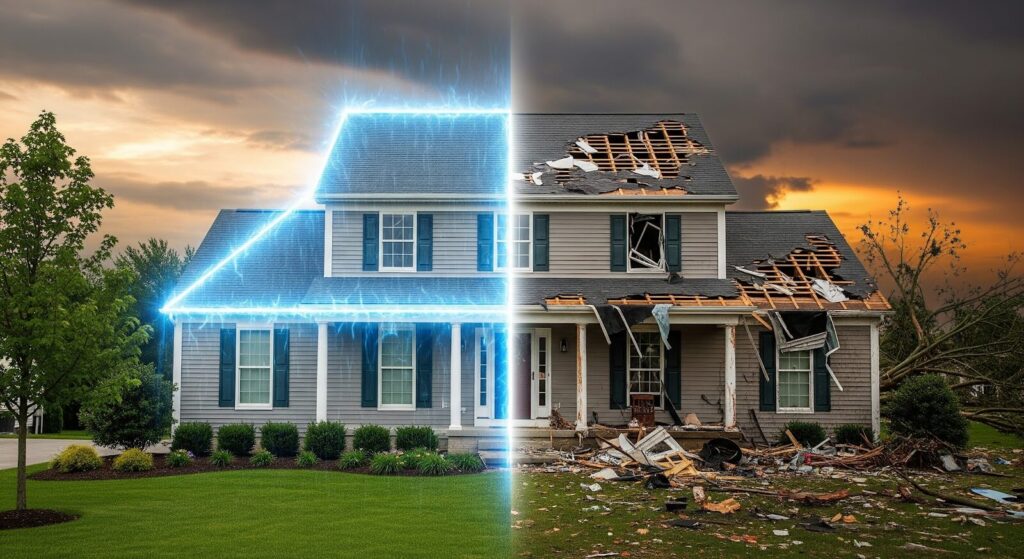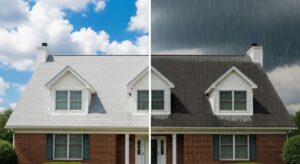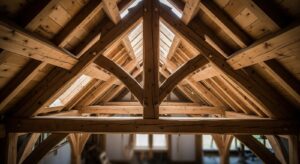Storms don’t exactly send a polite warning before tearing through neighborhoods. One night of high winds or hail can leave a roof battered in ways that aren’t immediately obvious. That’s why a proper roof storm damage assessment is essential—it’s the first step in protecting your home, your safety, and your wallet.
What Is Roof Storm Damage Assessment?
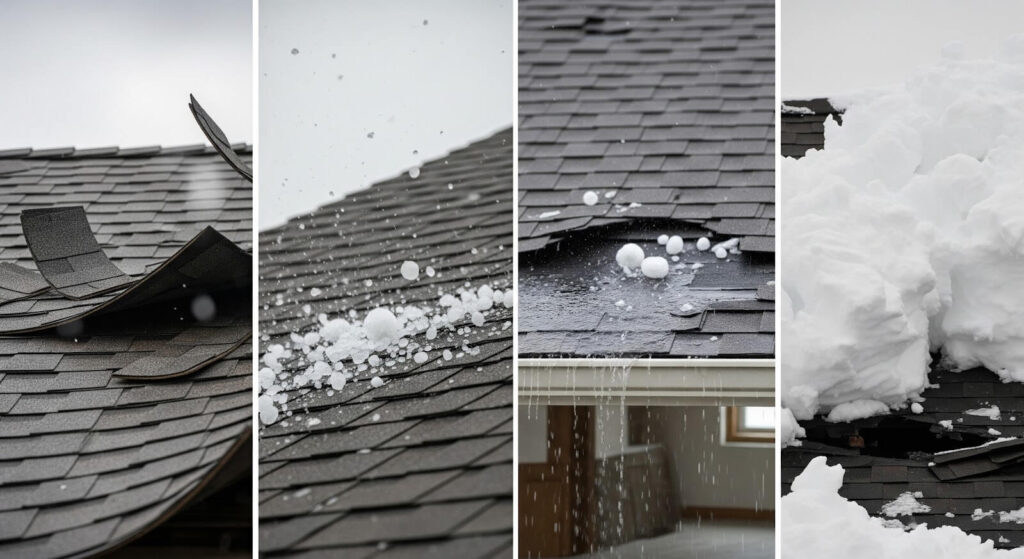
Put simply, roof storm damage happens when harsh weather—wind, hail, heavy rain, snow, or ice—weakens or breaks parts of your roofing system. Think of your roof as a shield. When storms hit, they can chip, dent, or puncture that shield, leaving your home exposed.
Different types of storms cause different problems:
- Windstorms can lift shingles like loose playing cards.
- Hailstorms leave dents, bruises, and cracks in shingles.
- Heavy rain seeps into even the tiniest gaps.
- Snow and ice pile on weight and can form ice dams that push water under shingles.
The result? A roof that may look fine from the curb but is silently allowing water inside.
Why Roof Damage Shouldn’t Be Ignored
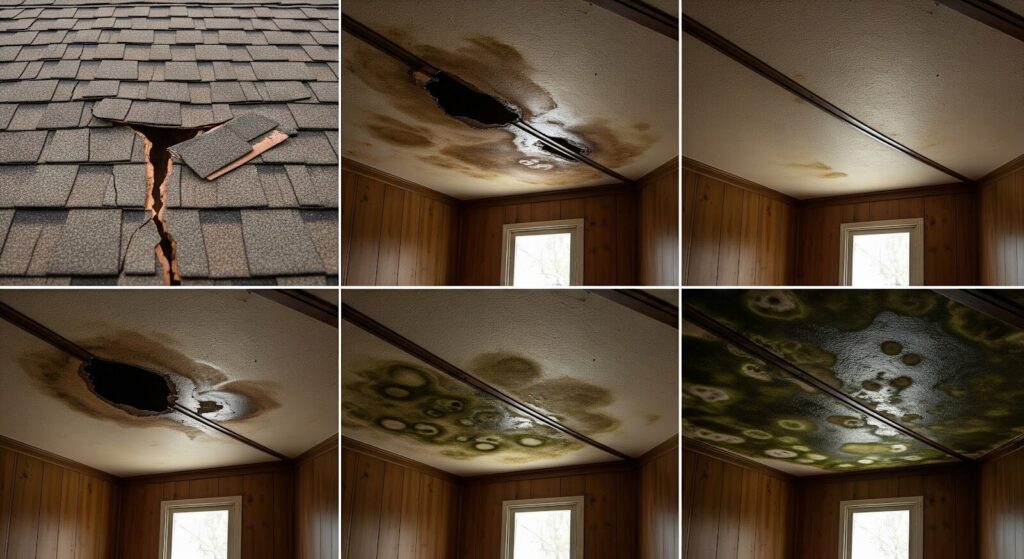
A small crack in a shingle today can turn into a soggy ceiling tomorrow. Here’s why procrastinating on a roof damage evaluation is a bad idea:
- Leaks and water damage – Once water sneaks in, it doesn’t stay put. It travels, staining ceilings, ruining drywall, and soaking insulation.
- Mold and structural risks – Damp wood is mold’s favorite playground. Left unchecked, it can weaken beams and spread health hazards.
- Property value – Buyers notice water stains and warped walls. A storm-damaged roof can slash resale value and complicate insurance claims.
Ignoring roof damage is like ignoring a cavity. It never gets better on its own.
Common Signs of Roof Storm Damage
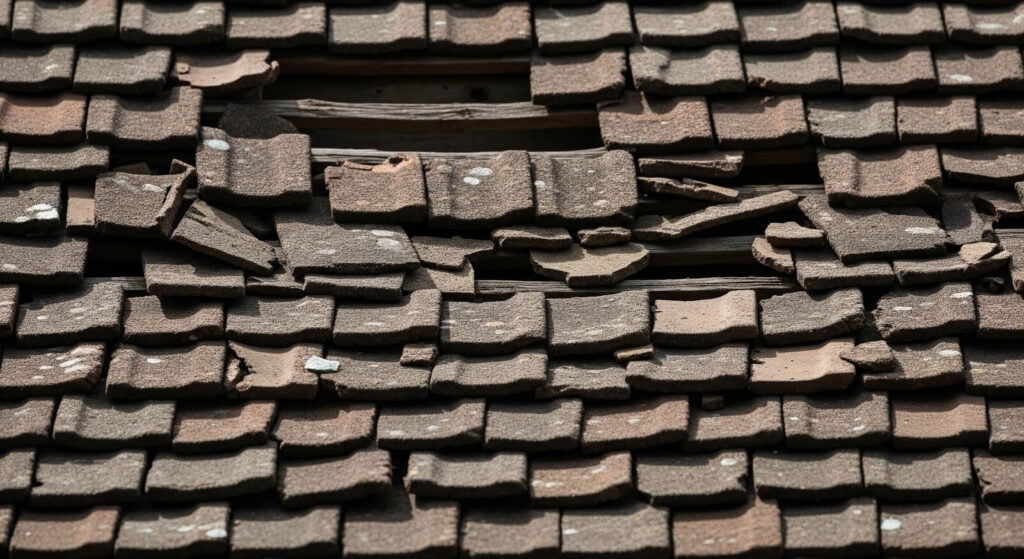
Spotting issues early saves time and money. Here’s what to look for:
- Shingle problems – Missing, cracked, or curled shingles stick out like crooked teeth.
- Granule loss – Asphalt shingles shed tiny granules when damaged. Check gutters and downspouts for gritty buildup.
- Water stains – Brownish spots on ceilings or walls often mean leaks.
- Sagging or soft spots – A spongy roof deck suggests hidden water damage.
- Damaged flashing or chimney caps – These metal barriers keep water out; if they’re bent or missing, water finds a way in.
Types of Storm Damage to Roofs
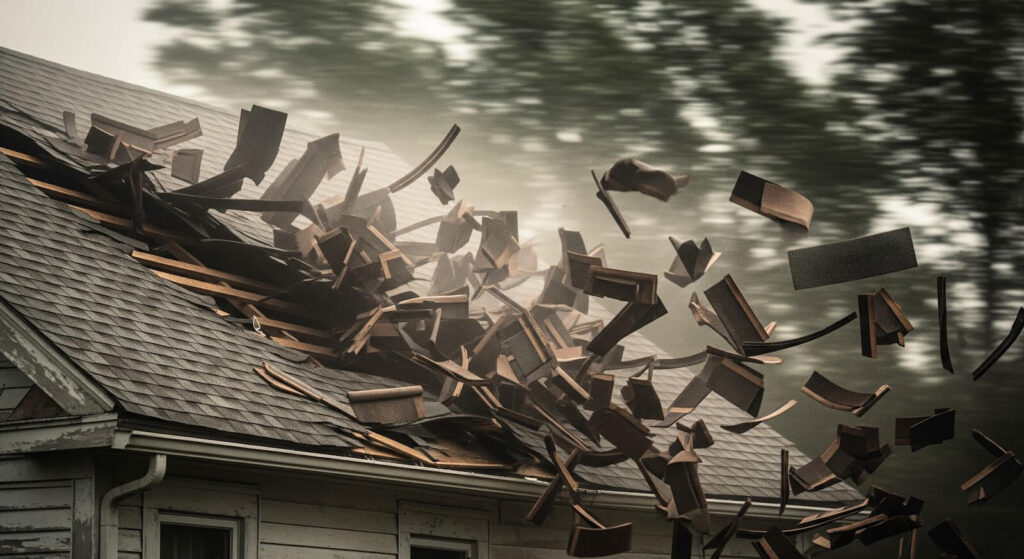
Not all damage looks the same. Knowing the differences helps you explain issues to a roofer or insurer:
1. Wind Damage
High winds lift shingles and sometimes tear them off completely. The result is exposed underlayment and nails, leaving water a direct entry point.
2. Hail Damage
Hail acts like nature’s baseballs. It leaves dents, chips off protective granules, and can puncture shingles or skylights. Over time, this speeds up roof aging.
3. Water Damage
Pooling water can rot wood and weaken the roof deck. Inside, it shows up as damp insulation, peeling paint, or musty odors.
4. Snow and Ice Damage
Ice dams form when heat escapes into the attic, melting snow that then refreezes at the roof’s edge. This forces water backward under shingles.
5. Debris Impact Damage
Tree branches and flying objects don’t just dent shingles—they can punch holes. Even small debris like twigs can scrape protective layers off shingles.
How to Safely Inspect Your Roof After a Storm
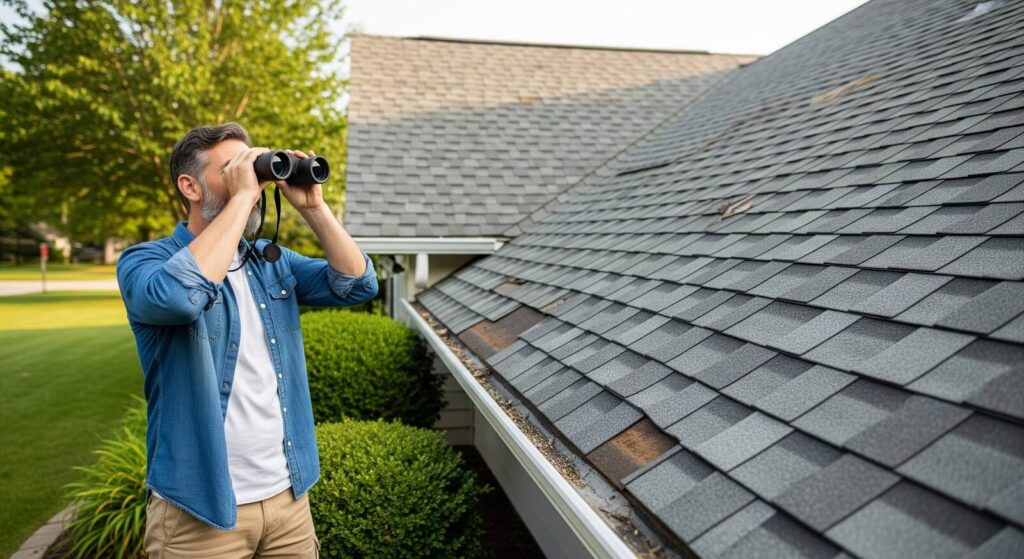
Climbing onto a slippery roof isn’t worth the risk. Here’s a safe step-by-step:
- Start on the ground – Walk the perimeter and look for fallen shingles or debris.
- Use binoculars or a drone – A zoomed-in look shows curled edges, cracks, or missing patches.
- Check inside – Peek into the attic for water stains, damp insulation, or sunlight poking through.
- Stay grounded – Avoid climbing on wet or damaged roofs—it’s dangerous and can make damage worse.
- Document everything – Snap photos and videos of visible issues; these are gold for insurance claims later.
DIY Fixes vs Professional Repairs
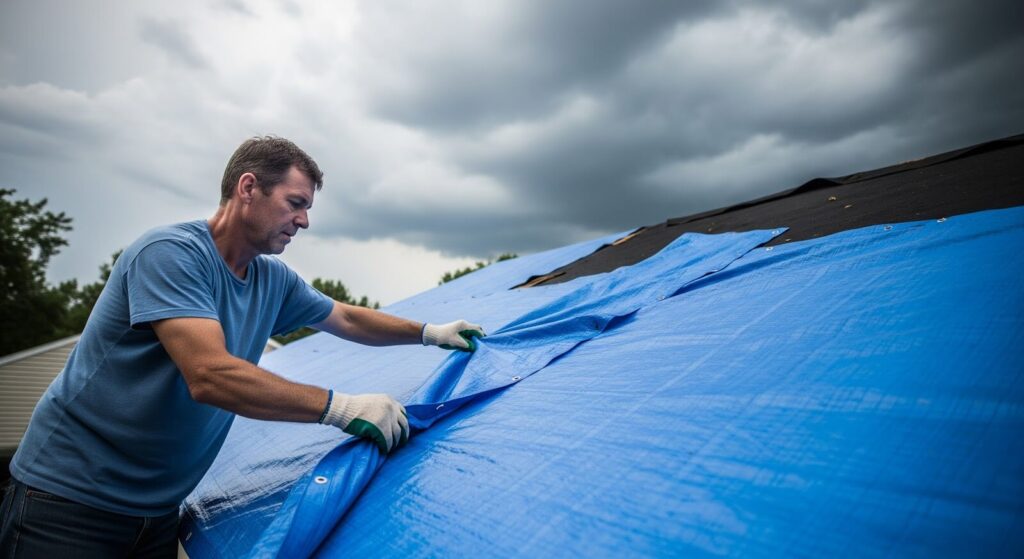
Some damage calls for a roofer, while other small tasks can buy you time.
- DIY Temporary Fixes: Cover small leaks with a tarp, reattach loose gutters, or clear debris from downspouts.
- Risks of DIY: Roofing is one of the most dangerous home projects. A slip can land you in the ER, and improper patching can void warranties.
- When to Hire a Pro: If shingles are missing, flashing is bent, or leaks are spreading, call a licensed roofing contractor. They’ll do a thorough roof damage evaluation and recommend safe, lasting repairs.
How to File a Storm Damage Insurance Claim
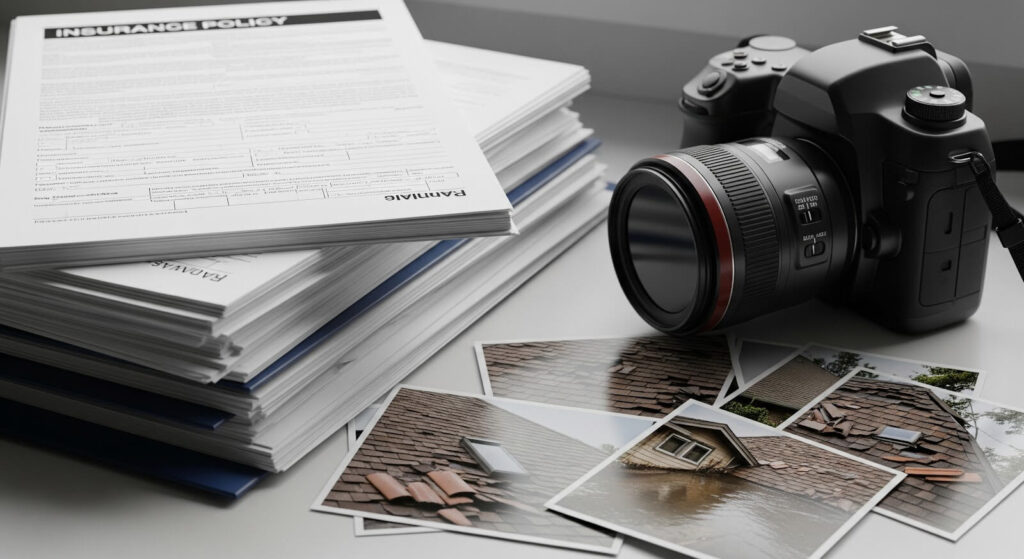
Filing insurance can feel overwhelming, but breaking it into steps makes it manageable:
- Review your policy – Know what storm damage your coverage includes.
- Document the damage – Use photos, videos, and notes about the date of the storm.
- Contact your provider – File promptly; waiting too long can complicate approval.
- Meet the adjuster – They’ll inspect your roof to verify the claim.
- Get contractor quotes – Compare estimates from licensed roofers so you’re prepared if the insurer’s payout falls short.
Pro tip: Many roofing contractors offer to meet the adjuster with you to ensure nothing is overlooked.
Ready to protect your investment? Start with understanding what professional assessors look for in residential roof inspections, then have contact information for certified assessors ready before you need it.
Tips to Prevent Future Roof Storm Damage
Storms are unpredictable, but prevention is possible:
- Routine inspections – Have a roofer check your roof twice a year.
- Clear gutters – Blocked gutters cause water to back up under shingles.
- Trim branches – Overhanging trees are an open invitation for debris damage.
- Upgrade materials – Impact-resistant shingles, metal roofing, and reinforced flashing can handle storms better.
- Improve ventilation – Proper attic airflow reduces heat buildup and ice dam risks.
Think of prevention like going to the dentist. Regular checkups save you from painful, expensive fixes later.
Frequently Asked Questions
1. How do I know if my roof damage is storm-related or just old age?
Storm damage often appears suddenly—missing shingles, dents, or leaks right after a storm. Age-related wear is gradual, with general curling, fading, or brittle shingles.2. Can I stay in my home while the roof is being repaired?
Yes, most repairs allow you to stay put, unless there’s major structural damage or a full replacement in progress.3. Will insurance cover the full cost of roof replacement?
It depends on your policy. Many cover replacement cost, but some only reimburse actual cash value (factoring in depreciation).4. How long after a storm should I wait to inspect my roof?
Check as soon as it’s safe—delays may worsen damage and weaken your insurance claim.5. What temporary fixes can I do while waiting for a roofer?
Tarp the damaged area and clear clogged gutters to minimize water intrusion.6. How often should I have my roof inspected in a storm-prone area?
At least twice a year (spring and fall) and after any major storm.7. Are impact-resistant shingles worth the investment?
Yes. While pricier upfront, they can last longer, lower repair costs, and sometimes even reduce insurance premiums.8. What happens if I ignore minor storm damage?
It worsens over time—leading to leaks, mold, higher repair bills, and potential insurance claim denials.9. How can I find a trustworthy roofing contractor?
Look for licensed, insured professionals with strong reviews and local references. Avoid “storm chasers” who show up only after big storms.10. Can multiple small storms cause cumulative roof damage?
Absolutely. Even if each storm only leaves minor marks, the damage adds up and shortens roof lifespan.Conclusion
A roof takes the brunt of every storm so your home doesn’t have to. But shields wear down. A thoughtful roof storm damage assessment—done safely and promptly—protects your home from leaks, mold, and costly repairs. With the right mix of inspections, preventative care, and professional help when needed, you can face future storms with confidence.

